Unlocking the Power of WordPress: A Guide to Installation and Website Creation

In the vast and ever-evolving realm of website development, WordPress has emerged as a prominent and user-friendly platform for creating stunning websites. Whether you are an aspiring blogger, a small business owner, or a seasoned developer, WordPress offers a versatile and intuitive solution for building and managing websites. In this article, we will explore the purpose of WordPress, delve into the process of installing it, and provide a step-by-step guide to creating your own website.
Understanding the Purpose of WordPress
WordPress is a popular content management system (CMS) that allows individuals and businesses to create and manage websites without the need for extensive coding knowledge. Originally developed as a blogging platform, WordPress has evolved into a robust CMS that powers millions of websites across various industries. Its flexibility, vast selection of themes and plugins, and user-friendly interface make it an ideal choice for beginners and professionals alike.
Installing WordPress: Step-by-Step Guide
Choose a Hosting Provider: Before installing WordPress, you need a hosting provider that will store your website’s files and make them accessible on the internet. Look for a reputable hosting provider that meets your specific needs, such as Bluehost, SiteGround, or WP Engine. If you like, you can try it on your own computer using WAMP Server.
Register a Domain: A domain is the address of your website on the internet (e.g., www.yourwebsite.com). Most hosting providers offer domain registration services. Choose a domain name that reflects your brand or website’s purpose and check its availability.
Install WordPress: Many hosting providers offer a simple one-click WordPress installation process. Once you have signed up for hosting and registered a domain, log in to your hosting account and look for the WordPress installation option. Follow the prompts and fill in the required details, such as your website name, username, and password.
Accessing Your WordPress Dashboard: After the installation process is complete, you can access your WordPress dashboard by adding “/wp-admin” to the end of your domain (e.g., www.yourwebsite.com/wp-admin). Log in using the username and password you created during the installation.
Creating Your Website with WordPress
Choose a Theme: WordPress offers a vast library of free and premium themes that determine the overall look and design of your website. Browse through the options and select a theme that aligns with your brand or website’s purpose. You can customize the theme further by changing colors, fonts, and layout options.
Installing and Activating Plugins: Plugins are extensions that add specific functionality to your WordPress website. From contact forms to search engine optimization (SEO) tools, plugins enhance the features and capabilities of your site. To install a plugin, go to “Plugins” in your WordPress dashboard, click “Add New,” search for the desired plugin, and click “Install” followed by “Activate.”
Customizing Content and Pages: WordPress utilizes a simple and intuitive interface for managing your website’s content. To create a new page, go to “Pages” in your dashboard and click “Add New.” You can add text, images, videos, and other media elements using the provided editor. Similarly, you can create blog posts by going to “Posts” and clicking “Add New.”
Managing Menus and Widgets: WordPress allows you to create customized menus and add widgets to your website’s sidebar, footer, or other designated areas. To manage menus, go to “Appearance” and select “Menus.” From there, you can create and arrange menus by adding pages or custom links. To manage widgets, go to “Appearance” and select “Widgets.” Drag and drop desired widgets into available widget areas.
Publishing and Maintaining Your Website: Once you are satisfied with the content and design of your website, click the “Publish” button to make it live on the internet. Regularly update your content, install updates for themes and plugins, and perform backups to ensure your website stays secure and up to date.
Conclusion
WordPress continues to revolutionize the way individuals and businesses create websites, offering a user-friendly and feature-rich platform that caters to various needs. By following the installation process and utilizing the customization options, anyone can harness the power of WordPress to bring their online presence to life. Embrace the endless possibilities and embark on a journey of website creation with WordPress as your trusted companion.







